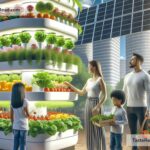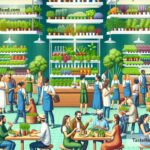The Future of Food and Climate Resilience: A Path Toward Sustainable Solutions
The food we eat is deeply connected to the health of our planet. Every crop grown, every animal raised, and even the transportation of food shapes the world around us. But with climate change becoming more severe, the future of food is under threat. Floods, droughts, and rising temperatures are making it harder for farmers to grow crops. At the same time, feeding a growing global population means we need to produce even more food in the years ahead. So, how can we ensure everyone gets enough to eat while protecting the planet? The answer lies in creating food systems that are climate-resilient and sustainable.
The Challenge: Climate Change and Food Systems
Climate change affects food production in many ways. For example, rising temperatures can damage crops that need cool weather, such as wheat. Droughts dry out the soil, making it harder for plants to grow, while floods wash away seeds and plants altogether. Extreme weather events, like hurricanes and heatwaves, are also becoming more frequent and destructive.
At the same time, agriculture itself contributes to climate change. Growing crops and raising livestock account for roughly one-third of global greenhouse gas emissions. Clearing forests for farmland releases carbon dioxide, while animals like cows produce methane, a powerful greenhouse gas. Fertilizers and pesticides also pollute the air, soil, and water.
As the climate changes, farmers and food producers need to adapt. But creating climate-resilient systems is no small task. It requires innovation, collaboration, and a global commitment to change.
Solutions for a Resilient Future
Although the challenges are big, there’s hope. Scientists, farmers, and governments are working together to build more resilient food systems. Here are some of the most promising solutions:
1. Climate-Smart Farming
Climate-smart farming uses techniques that protect crops and reduce emissions. For example, growing certain crops together can help keep soil healthy and prevent pests. Farmers can also plant cover crops, which protect the soil from erosion and add nutrients. Irrigation systems that use water more efficiently can help farmers deal with droughts.
Additionally, using technology like drones, sensors, and AI can help farmers plan better. These tools provide real-time data on soil health, weather patterns, and crop growth. With this information, farmers can make smarter decisions that save time, money, and resources.
2. Innovative Food Production
In the future, we might rely more on alternative ways to produce food. For example, vertical farming grows crops in layers, often indoors, using less land and water. Similarly, hydroponics and aquaponics use nutrient-rich water to grow plants without soil. These methods are space-efficient and can produce food year-round, regardless of weather conditions.
Cultured meat, often called “lab-grown meat,” is another exciting innovation. Instead of raising animals for meat, scientists grow it from animal cells. This process uses fewer resources and produces less methane, making it better for the environment.
3. Diversifying Diets
Another important solution is diversifying what we eat. Globally, many people rely on a few staple crops like rice, wheat, and corn. But these crops are vulnerable to climate change. Eating a wider variety of foods can protect against shortages. For example, quinoa, millet, and amaranth are hardy grains that can thrive in tough conditions.
We can also explore protein alternatives like beans, lentils, insects, and plant-based proteins. These foods use fewer resources to produce than traditional animal meat and are nutritious options.
4. Reducing Food Waste
One-third of all food produced globally is wasted. This waste contributes to greenhouse gas emissions and puts pressure on food systems. By reducing food waste, we can save resources and help feed more people.
Governments, restaurants, and grocery stores are working on solutions, such as donating surplus food instead of throwing it away. Households can also play a big role by planning meals, storing food properly, and using leftovers creatively.
5. Supporting Farmers and Communities
Farmers are on the frontlines of climate change, and they need support to adapt. Governments and organizations can provide training, equipment, and financial help to small-scale farmers. Education is also key—empowering farmers with knowledge about climate-smart practices can make a big difference.
Additionally, investing in local food systems can strengthen communities. When food is grown closer to home, it reduces transportation emissions and supports local economies.
The Role of Everyone: Consumers and Policy Makers
Every person has a role to play in shaping the future of food. As consumers, we can make choices that are better for the environment—buying locally-produced food, eating more plant-based meals, and wasting less food are good places to start.
Policy makers have an even bigger responsibility. They must create laws and programs that reduce emissions, protect farmland, and invest in sustainable technologies. International cooperation is also crucial because food production and climate change are global issues.
A Shared Responsibility for the Future
The future of food is both a challenge and an opportunity. By developing climate-resilient systems, we can protect the planet while feeding a growing population. Farmers, scientists, governments, and consumers all have a part to play. It’s not just about solving immediate problems—it’s about building a sustainable future for generations to come.
Climate resilience starts with collaboration and innovative thinking. The good news is, solutions already exist. All we need now is the will to act. Together, we can create a food system that’s healthy for people and the planet.


